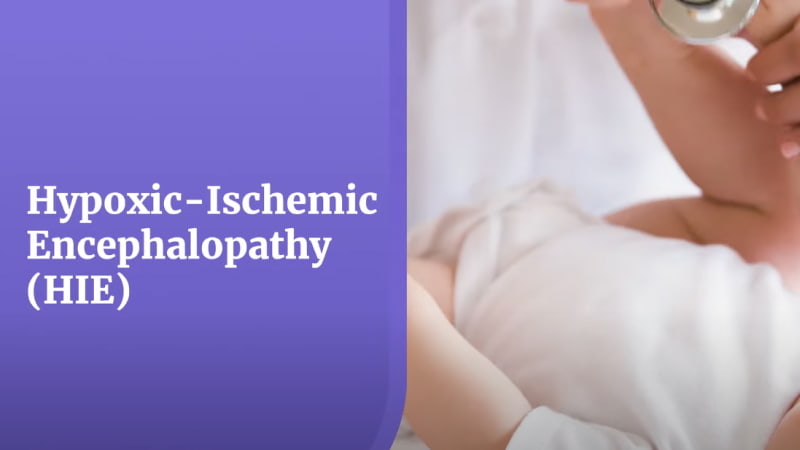What Is Hypoxic-Ischemic Encephalopathy?
Neonatal hypoxic-ischemic encephalopathy is a type of birth asphyxia in which a baby’s brain doesn’t get enough blood (ischemia) or oxygen (hypoxia).
The development of HIE starts when there is a restriction of blood flow to the brain, which decreases the amount of oxygen and glucose (sugars) and increases the amount of calcium in the brain cells. The heightened calcium levels can cause brain cells to die.
If too many brain cells die, the child may be left with permanent neurological impairments like cerebral palsy.
Learn about hypoxic-ischemic encephalopathy (HIE), a serious condition affecting newborns during childbirth, and what to do if your baby was harmed. View Transcript.
Duration: 1 min 03 sec
Infant hypoxic-ischemic encephalopathy, or HIE, is a life-threatening condition that can affect unborn children and newborn babies.
It occurs when a baby doesn’t receive enough oxygen or blood flow during the birthing process causing brain cells to die.
Without immediate treatment, severe HIE can result in permanent disabilities like cerebral palsy, brain damage — and even death.
According to the American Medical Association, HIE is estimated to cause more than 1 million deaths each year across the world.
The important thing to know is that some cases of HIE are preventable, which means they could have been caused by a doctor or health care professional’s medical mistakes.
You may have legal options if your baby’s HIE was caused by medical malpractice. Connect with the team at the Birth Injury Justice Center today to learn more. Our trained labor and delivery nurses are standing by to talk with you.
Further, a lack of oxygen and blood flow to other organs — such as the kidneys, liver, or heart — may cause permanent harm. The length of oxygen deprivation usually determines the extent of the brain or organ damage.
Not all cases of HIE cause lasting harm — however, the risk of lifelong health problems like cerebral palsy shouldn’t be ignored.
Causes of Hypoxic-Ischemic Encephalopathy
The most common causes of HIE are other problems that may appear before, during, or shortly after the birth of a full-term infant.
These causes include and are not limited to:
- An extended labor and delivery period
- Detachment of the placenta from the uterus
- Impaired lung function
- Medical negligence, such as the doctor not addressing fetal distress
- Placental abruption (rupture)
- Prolonged pinching or a true knot in the umbilical cord
Do you believe medical malpractice led to your child’s Hypoxic-Ischemic Encephalopathy?
Hypoxic-Ischemic Encephalopathy Risk Factors
Some research has drawn parallels between preterm delivery and increased incidence and severity of HIE. Due to the higher vulnerability of the preterm brain, impairments to brain development may be greater, and recovery will follow a more complex clinical course.
The following may also increase the risk of HIE:
- Pre-eclampsia (extremely high blood pressure)
- Very low blood pressure
- Maternal infection, such as pelvic inflammatory disease
- Drug/alcohol abuse
Some of these risk factors can be mitigated by high-quality prenatal care.
Signs and Symptoms of HIE
There are a number of signs and symptoms associated with HIE that warrant further examination and emergency treatment. Seek medical help immediately if you think your child has suffered from HIE.
Physical signs of HIE include:
- A weak cry
- Decreased or increased reactions to sights and sounds
- Developmental delays
- Floppy or weak muscle tone with poor reflexes
- Movement abnormalities
- Pale or bluish skin
- Seizures
- Weak or absent breathing patterns
Infants with mild HIE may not display seizures. Some literature indicates that the timing of the initial onset of seizures is related to HIE’s severity.
For example, children in the moderate severity level will often display seizures within the first few hours of life, but then seizures subside within approximately 24 hours. Infants in the severe category, however, typically have a delay in their seizure onset.
Other signs of HIE are usually only caught by medical professionals shortly before, during, or shortly after delivery.
These medical signs include:
- Lesions in the brain’s white matter
- Meconium in the amniotic fluid (this means the child had a stool pre-birth, a sign of fetal distress)
- Vital organ dysfunction (such as heart, lungs, kidneys)
Hypoxic-Ischemic Encephalopathy Diagnosis
A definitive diagnosis of hypoxic-ischemic brain injury requires numerous imaging, clinical, and laboratory tests.
Common tests used to diagnose HIE include:
- Ultrasonography
- Electroencephalography (EEG)
- Electrocardiography (EKG or ECG)
- Neuroimaging tests like magnetic resonance imaging (MRI)
Deafness is a common result of HIE, so a hearing test is part of the diagnostic process. An ophthalmic evaluation will also be necessary to examine the baby’s eyes and eyesight.
Other laboratory tests can provide important diagnostic information on liver, renal, and cardiac function.
HIE-Related Diagnoses
Hypoxic-ischemic encephalopathy can result in a number of secondary diagnoses, ranging from mild to severe.
Common HIE-related diagnoses include:
- Autism
- Behavioral challenges
- Cerebral palsy
- Epilepsy
- Learning and attention disorders
- Secondary microcephaly (smaller-than-normal sized head)
These diagnoses may be apparent at birth. But in many cases, they won’t emerge until the child is older and starts missing certain brain development milestones.
For example, some behavioral challenges may not occur until age 10, when the frontal lobe begins to develop. It can take years to determine how a child will be affected by HIE.
Hypoxic-Ischemic Encephalopathy Stages
There are two types of injury with HIE, classified in stages.
- The first stage occurs immediately after the child’s brain is deprived of oxygen.
- In the second stage, as normal oxygenated blood starts to flow, reperfusion injury occurs as the damaged cells begin to release toxins.
Severity Levels
HIE may be normal/mild, moderate, or severe. These levels refer to the Sarnat Scale, which rates HIE based on a child’s condition right after birth.
This scale evaluates the following items:
- Autonomic function (e.g., heart, lungs, and respiration)
- Complex reflexes
- Gastrointestinal motility (how well the body moves the passage of food)
- Level of consciousness/alertness
- Secretions of the mouth and lungs
- Seizures
Hypoxic-Ischemic Encephalopathy Treatment Options
Doctors typically combat HIE using therapeutic hypothermia treatment, commonly known as brain cooling. During this process, infants are placed on a cooling blanket for about three days and also given medicines to help them rest. They are closely monitored for any signs of distress.
After the cooling period, the infant is slowly re-warmed, and nutrition is provided intravenously. Heart rate, breathing status, and body temperature are consistently monitored. Brain activity is also evaluated via an EEG and cerebral function monitor.
Other Therapies for Treating HIE
Other organs harmed by HIE may require additional treatments, such as:
- Cardiac care
- Care of kidney and liver function
- Mechanical ventilation (breathing tube)
- Seizure prevention medications
Infants should also begin a course of physical, occupational, and other therapies to help them adapt to symptoms caused by the brain injury.
Hypoxic-Ischemic Encephalopathy Prognosis
Global figures indicate that HIE is the fifth-largest cause of death in children ages five and younger. It is estimated that it leads to 920,000 neonatal deaths per year.
The quality of health care can be a major factor in mortality and morbidity. Long-term outcomes also often correlate with the severity of the HIE.
Hypoxic-Ischemic Encephalopathy in Adults
HIE may cause babies to suffer from health problems through adulthood if their brains are permanently damaged.
Of those who survive moderate HIE, 30-50% have major long-term complications. Of those who survive severe HIE, up to 80% have lasting health conditions.
Autism, cerebral palsy, and most of the other conditions linked to HIE do not affect life expectancy. That said, they may require lifelong treatments or lead to other complications.
Otherwise, healthy adults can also develop HIE, typically as the result of a heart attack or cerebrovascular disease, which damages blood vessels in the brain.
Financial Compensation for Preventable HIE
In some cases, doctors can prevent a child from suffering from HIE with proper medical care. If your child has been harmed by this life-threatening condition, you may be able to take legal action and pursue compensation from the doctors at fault. Contact a nationwide birth injury lawyer today for more information.
Compensation can help your family afford:
- Costs of medical treatments, including surgery and medication
- Adaptive equipment, such as a wheelchair
- Therapy sessions
Get a free case review from our team today to see if you can access financial compensation for birth injuries like HIE.




